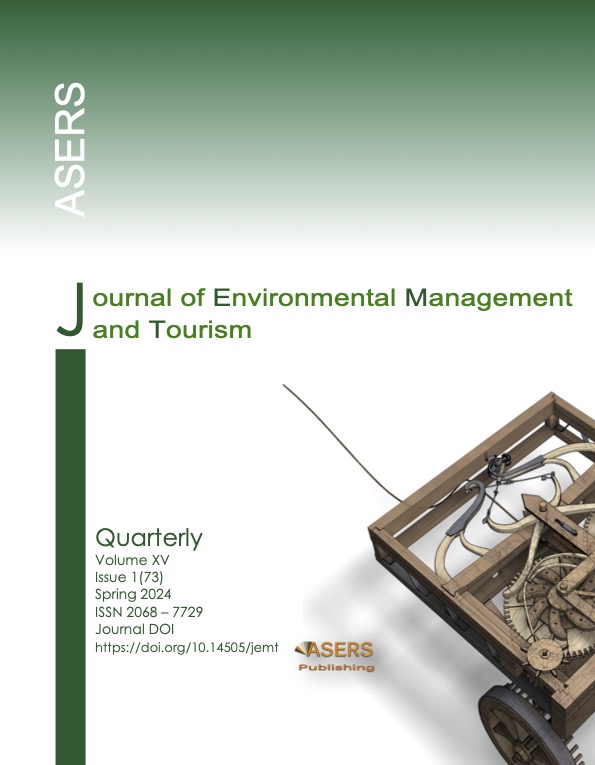QR Code Use and Identification Problems in Tourism
Abstract
The integration of technology with tourism increases its efficiency and improves the tourist experience, especially through QR codes and NFC technologies, which are already widely used. The number of research related to digitization and the sustainability of tourism is increasing, and the focus is shifting towards ICT, AR and VR. Mobile services like QR codes are crucial in tourism, improving service availability and user experience. The article analyzes the importance of QR codes and image processing in logistics and tourism. The focus is on the technological foundations, recognition, and decoding methods of QR codes, highlighting the role of artificial intelligence. The article discusses in detail the application of QR codes in tourism, along with technological challenges and development opportunities. It also presents future research directions and the potential effects of QR codes on tourism.
References
[2] Automatic Identification and Data Capture Techniques - QR Code Bar Code Symbology Specification, ISO/IEC, Switzerland, 2015. DOI: https://webstore.ansi.org/Previews/PREVIEWISO+IEC+18004-2015.pdf
[3] Bódi, S. 2023. Presentation of the Fundamental Law of Hungary, Lawyer Quarterly, 13(3): 296-307.
[4] Bodnár, P. and Nyúl, L. 2015. Improved QR code localization using boosted cascade of weak classifiers. Acta Cybernetica, 22(1): 21–33. DOI: https://doi.org/10.14232/actacyb.22.1.2015.3
[5] Canadi, M., Höpken, W. and Fuchs, M. 2010. Application of QR Codes in Online Travel Distribution. In: Gretzel, U., Law, R., Fuchs, M. (eds) Information and Communication Technologies in Tourism 2010. Springer, Vienna. DOI: https://doi.org/10.1007/978-3-211-99407-8_12
[6] Chou, T.H., Ho, C.S. and Kuo, Y.F. 2015. QR Code Detection Using Convolutional Neural Networks. In Proceedings of the 2015 International Conference on Advanced Robotics and Intelligent Systems (ARIS), Taipei, Taiwan, pp. 1–5.
[7] Ekundayo, S., Baker O. and Zhou, J. 2020. QR Code and NFC-Based Information System for Southland Tourism Industry-New Zealand, 2020 IEEE 10th International Conference on System Engineering and Technology (ICSET), Shah Alam, Malaysia, pp. 161-166. DOI:https://doi.org/10.1109/ICSET51301.2020.9265394
[8] Forman, N. and Udvaros, J. 2023. Digital Innovation in Hospitality: Bridging the Gap between Concierge Services and Hotel Guests. Journal of Environmental Management and Tourism, 14(6): 2673 - 2684. DOI:https://doi.org/10.14505/jemt.v14.6(70).15
[9] Gubán, M. and Udvaros, J. 2022. Új módszerek a raktárkészlet ellenőrzés területén. Logisztikai trendek és legjobb gyakorlatok, 8(1): 39-42. DOI: https://doi.org/10.21405/logtrend.2022.8.2.7
[10] Hasanuzzaman, T., Rahman, S., Thakur, S. and Hossain, S. 2022. 10 The Ubiquitous Role of Mobile Technology Application in the Australian Open. Digital Transformation and Innovation in Tourism Events.
[11] Huo, L., Zhu, J., Singh, P.K. and Pavlovich, P.A. 2021. Research on QR image code recognition system based on artificial intelligence algorithm. J. Intell. Syst. 30: 855–867. DOI: https://doi.org/10.1515/jisys-2020-0143
[12] Jiang, C. and Phoong, S.W. 2023. A ten-year review analysis of the impact of digitization on tourism development (2012–2022). Humanit Soc Sci Commun, 10: 665. DOI: https://doi.org/10.1057/s41599-023-02150-7
[13] Karrach, L., Pivarčiová, E. and Božek, P. 2020. Identification of QR code perspective distortion based on edge directions and edge projections analysis. Journal of imaging, 6(67). ISSN 2313-433X.
[14] Mariotto, P., et al. 2022. A New Way to Explore Volcanic Areas: QR-Code-Based Virtual Geotrail at Mt. Etna Volcano, Italy. Land, 11(3): 377. DOI: https://doi.org/10.3390/land11030377
[15] Shettar, IM. 2016. Quick response (QR) codes in libraries: case study on the use of QR codes in the central library, NITK. Proc. TIFR-BOSLA National Conference on Future Librarianship. Mumbai: Imperial Publications; p. 129–34.
[16] Szentandrási, I., Herout, A. and Dubská, M. 2013. Fast detection and recognition of QR codes in high-resolution images. In Proceedings of the 28th Spring Conference on Computer Graphics, SCCG '12, pages 129-136, New York, NY, USA, ACM.
[17] Udvaros, J. and Bódi, S. 2023. Division and Regulation of Drones in EU and Hungary. International Journal of Science, Engineering and Technology, 11(4): 1-6.
[18] Udvaros, J., Gubán, Á. and Gubán, M. 2019. Methods of artificial intelligence in economical and logistical education. eLearning and Software for Education Conference, 414–421. DOI:http://dx.doi.org/10.12753/2066-026x-19-055
[19] Viola, P.A. and Jones, M.J. 2001. Rapid object detection using a boosted cascade of simple features, In IEEE Computer Society Conference on Computer Vision and Pattern Recognition (CVPR), pp. 511–518.
[20] Yanis, M., Zainal, M., Putra, R.A., and Paembonan, A.Y. 2023. Integration of QR-Code and web-based applications for developing digital tourism in Iboih Village, Indonesia as a lesson learned media on the volcanic island. GeoJournal TourismGeosites, 47 (2): 499–507. DOI: https://doi.org/10.30892/gtg.47217-1049
Copyright© 2025 The Author(s). Published by ASERS Publishing 2025. This is an open access article distributed under the terms of CC-BY 4.0 license.
